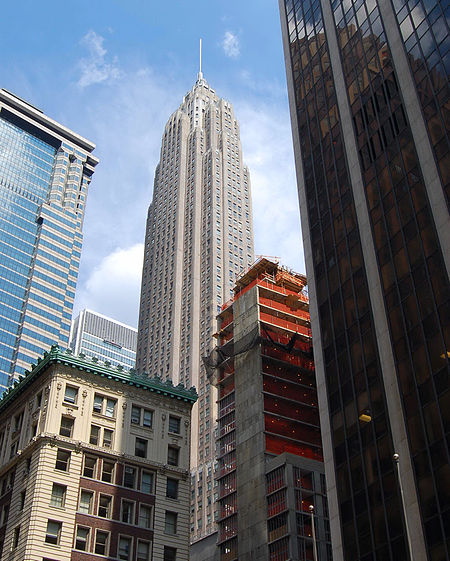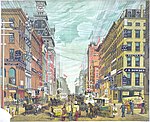70 Pine Street

70 Pine Street – formerly known as the 60 Wall Tower, Cities Service Building, and American International Building – is a 67-story, 952-foot (290 m) residential building in the Financial District of Lower Manhattan in New York City. It was designed by the firm of Clinton & Russell, Holton & George in the Art Deco style. 70 Pine Street, built in 1930–1932 by energy conglomerate Cities Service Company (later Citgo), was Lower Manhattan's tallest building and the world's third-tallest structure upon its completion. 70 Pine Street occupies a trapezoidal lot on Pearl Street between Pine and Cedar Streets. It features a brick, limestone, and gneiss facade with numerous setbacks. The building contains an extensive program of ornamentation, including the Cities Service Company's triangular logo and solar motifs. The interior features included escalators at the base and double-deck elevators linking the tower's floors. A three-story penthouse, intended for Cities Service's founder Henry Latham Doherty, was later utilized as a public observatory. 70 Pine Street's construction was funded through a public offering of stock, rather than a mortgage loan. Despite having been built during the Great Depression, the building was profitable enough that it broke even by 1936, with 90% of the space occupied five years later. The American International Group (AIG) bought the building in 1976, and it was acquired by another firm in 2009 after AIG went into bankruptcy. The building and its first floor interior were designated as official New York City landmarks in June 2011. In 2016, the building became a luxury rental residential property.
Excerpt from the Wikipedia article 70 Pine Street (License: CC BY-SA 3.0, Authors, Images).70 Pine Street
Pine Street, New York Manhattan
Geographical coordinates (GPS) Address External links Nearby Places Show on map
Geographical coordinates (GPS)
| Latitude | Longitude |
|---|---|
| N 40.706388888889 ° | E -74.0075 ° |
Address
70 Pine Street
Pine Street
10005 New York, Manhattan
New York, United States
Open on Google Maps








